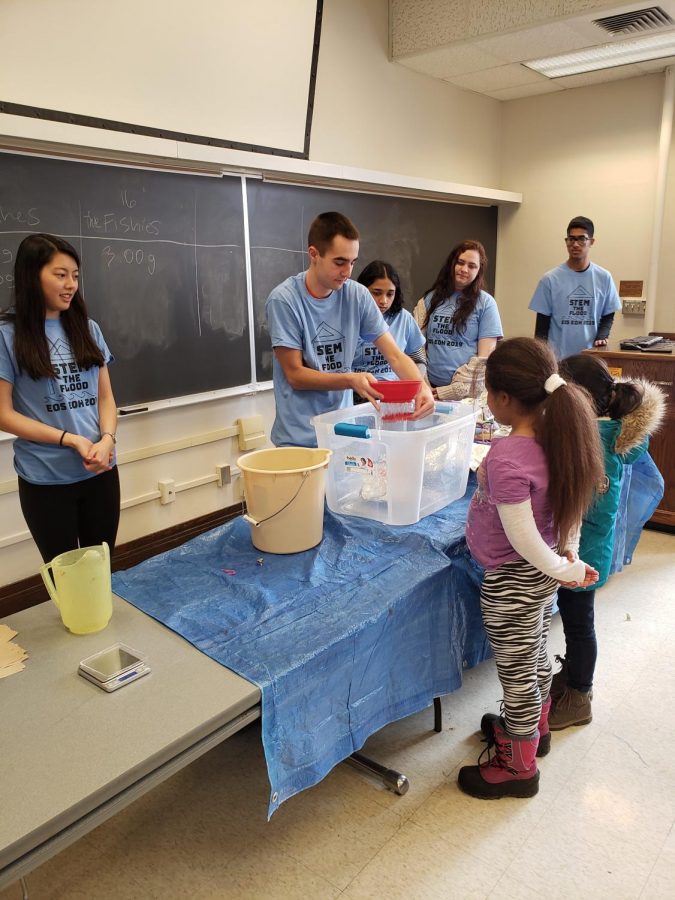University researchers receive $1.2 million grant
Photo Courtesy of Engineering Outreach Society
Members of Engineering Outreach Society test projects created by younger students during Engineering Open House on March 8. The University received a grant from the National Science Foundation to encourage more underrepresented students in middle and high school to pursue STEM fields.
Apr 8, 2019
Last updated on April 9, 2019 at 04:19 p.m.
University researchers received a $1.2 million grant from the National Science Foundation to fund a project that aims to encourage more low-income and underrepresented students in middle school and high school to consider STEM fields.
Lynford Goddard, professor in electrical and computer engineering and principal investigator of the research project, said a major reason for the study was the severe underrepresentation of African American, Hispanic, American Indian and female populations in most engineering fields.
“When we look at the future workforce for engineering and for science, we wanted to properly reflect the demographics of the population,” Goddard said. “We want to make sure that all the different communities of people are properly represented when you’re in a field that influences so much of what society does.”
The three-year grant will be used to partner with middle schools and high schools across the state. Projects, such as counselor support, STEM clubs and scholarships for immersive summer programs, will be implemented to develop students’ knowledge and self-efficacy in STEM fields.
Get The Daily Illini in your inbox!
The program emphasizes the role counselors play in STEM advocacy and creating opportunities for their students.
“We see them as gatekeepers for opportunities because a lot of times when programs and ideas come to schools, it goes to the counselors, and the counselors are the ones who recommend the students for certain opportunities like internships, after-school programs (and) enrichment activities,” Goddard said.
Teams of three will help promote the program and support students. The teams will consist of a counselor, teacher and another person, such as an activities coordinator, assistant principal or another teacher or counselor, depending on the school’s needs.
Lara Hebert, outreach coordinator for Engineering and co-principal investigator of the project, said having people in various roles is important because it brings different ideas to the table.
Throughout the year, teams will conduct action research on issues specific to their schools regarding access to STEM opportunities. They will also report on the program’s overall effectiveness in their schools and suggest ideas to improve practices.
Starting this summer, teams will attend a two-week summer training institute at the University to learn about STEM equity advocacy and STEM technical skills that can be taught in the STEM clubs.
Edison Middle School in Champaign was one of the schools that showed interest in participating in the research project.
“I can confidently say that all of the involved faculty are thrilled to be able to guide our students on this journey by providing them with the tools and opportunities to explore any and all aspects of STEM, and we can’t wait to see what amazing things they each choose to grow,” said Nathaniel Hall, an integrated STEM class teacher at the school, in an email.
Hall added the program will give counselors and STEM teachers a better foundational platform to partner with local experts who can help students, especially traditionally underrepresented students, understand STEM concepts better through clubs and other activities.
The study also emphasizes middle and high school are critical years in which students can envision themselves having a major or career in the STEM field.
“These experiences, the idea of the year interaction and the (year-round) encouragement to go into STEM, we think that that is going to be a transformative effect,” Goddard said.
A major goal of the project is to provide more students access to formal and informal STEM education. STEM clubs and scholarships to attend summer camps at the University are meant to address students’ exposure to informal STEM education.
STEM clubs will include activities based on a summer camp Goddard helps run for girls interested in electrical engineering. However, the clubs are meant to be self-sustaining and responsive to the needs of students.
“We want the STEM clubs to have the flexibility to pursue the interests of the students,” Goddard said. “If the students say, ‘We’re really excited about some other field in engineering, and we have an idea for a project,’ we want there to be flexibility for the students to be able to do those sorts of projects.”
The clubs will be equipped with $2,500 worth of equipment and $1,500 of flexible funding to buy materials to pursue their own projects and ideas.
Another aspect of informal STEM education is helping students be more aware of opportunities happening in the community, such as the Engineering Open House and pop-up events directed toward the community.
If the project proves to be successful in short- and long-term outcomes of students interested in STEM, the research team can apply to extend the grant and promote its model to other parts of the country.
“I’m hopeful that this grant is about relationships that are going to grow, that we’ll be able to maintain connections and continue working in supporting the STEM work and the STEM development happening in the schools that we partner with,” Hebert said.
Editors note: A previous version of this article said the clubs will be equipped with $250 worth of equipment. The Daily Illini regrets this error.






